Gezer › The Murder of Julius Caesar » Origins and History
Articles and Definitions › Contents
- Gezer › Ancient History
- The Murder of Julius Caesar › Antique Origins
Ancient civilizations › Historical places, and their characters
Gezer › Ancient History
Definition and Origins
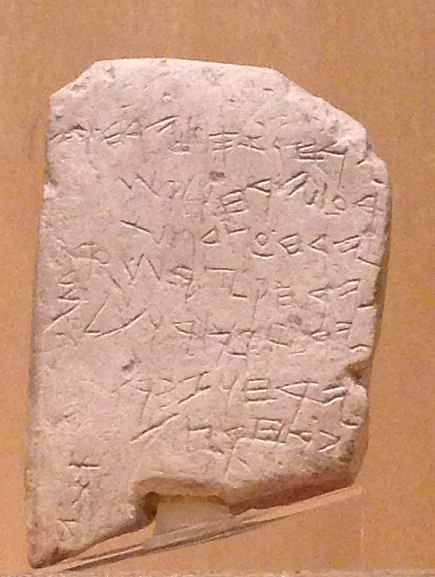
Gezer is an ancient city and archaeological site located in central Israel where the central mountains meet the northern Shephelah, about 10 km southeast of the city of Ramleh. According to the Hebrew Bible, Gezer was one of the great citiesfortified by Solomon, in addition to Jerusalem, Megiddo, and Hazor (1 Kings 9:15–17).
Gezer is located on a manmade mound or tell in Arabic—transliterated as tel in Latin characters from Hebrew - consisting of more than 25 layers of debris and soil, representing the material remains of successive periods of human occupation. The mound of Tel Gezer measures about 650 meters long east to west, by 200-250 meters wide, with hills on the east and west ends and a dip or "saddle" in between.
The site was inhabited from about 3500 BCE through the Roman period. It remained a small, unfortified settlement until the Middle Bronze Age (c. 2000-1500 BCE) (the "MB"), when stone fortifications were first constructed. Additional fortifications and monumental structures were built in the Iron Age, sometime from the 10th to the 8th century BCE, and the site continued to be inhabited until the Roman period.
GEOGRAPHY & EXCAVATIONS
Strategic location
Gezer occupied a strategic geographical position in antiquity. It was located just to the east of the Via Maris that ran from Egypt north along the sea and then east past Megiddo and on to Damascus. It was also on the "trunk road" that ran east through the hills to Jerusalem and on to Jordan. The trunk road ran around the north of the tell into the Aijalon Valley where the Hebrew Bible says that the moon "stayed" when Joshua commanded it to do so (Joshua 10: 12–13).
GEZER OCCUPIED A STRATEGIC GEOGRAPHICAL POSITION IN ANTIQUITY. IT WAS LOCATED JUST TO THE EAST OF THE VIA MARIS THAT RAN FROM EGYPT TO DAMASCUS.
Excavations of Tel Gezer
The site has been excavated several times in the past century. It was first excavated by the Irish archaeologist RAS Macalister for the Palestine Exploration Fund (PEF) in the early 20 th century CE, and then, more than 50 years later, by a joint expedition of the Hebrew Union College Biblical and Archaeological School (HUC) and the Harvard Semitic Museum in the 1960s CE and 1970s CE and by archaeologists from the University of Arizona in 1984 CE and 1990 CE. As of 2015 CE, it is currently being excavated by a team from the Tandy Institute for Archaeology at the Southwestern Baptist Theological Seminary (SBTS), and by a group from the Moskau Institute for Archaeology at the New Orleans Baptist Theological Seminary (NOBTS) which is excavating the Gezer Water System.
EARLIEST OCCUPATION OF THE SITE
The earliest evidence of occupation of Tel Gezer dates to the Early Bronze Age (EB), probably in the period from about 3500–3250 BCE. The period was called "Ghassulian-Beersheba," and during this time, the inhabitants initially lived in caves. Later, when they moved to other dwellings, they used the caves as tombs and crematoria. The tell was occupied throughout the EB, but the settlement was destroyed at the end of the EB in the 24 th century BCE.
THE MIDDLE BRONZE AGE (2000–1500 BCE)
In the earliest period of the MB, called the "Middle Bronze Age I" (MBI), the tell was again inhabited, as indicated by the presence of MBI pottery in the archaeological record. In the second part of the MB, called "Middle Bronze Age II" (MBII), around 1875–1850 BCE, the process of building the city began. Large fortifications were built throughout the site, including stone walls and towers, a glacis, and a gate on the western hill. The fortified city of the MB was destroyed in about 1500 BCE at the end of the MB.

The MB Canaanite gate after excavation.
The High Place
In the latest part of the MB II, called "Middle Bronze Age IIC" (MBIIC), ten stone columns, 1.65 to 3.25 meters tall, called the "High Place," were built at Gezer. They were also called "standing stones," "standing stelae," or " Massebot." The purpose of the stones of the High Place is not known, but it has been suggested that they were used for cultic purposes or perhaps as altars, possibly, for purposes of infant sacrifice. However, the longtime excavator of Tel Gezer, William G. Dever, recently rejected the last suggestion, pointing out that although there was evidence of infant sacrifice, it was found in a different stratum from that of the High Place. Instead, Dever suggested, the stones might have been used to memorialize a treaty among ten tribes in the area.
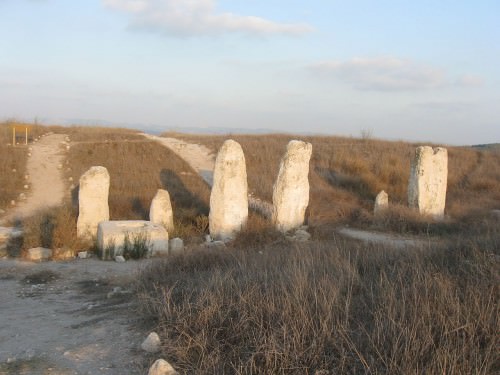
The standing stones of Gezer's
The Tel Gezer Water System
A sophisticated water system was constructed at Gezer in the MB, perhaps as early as 2000 BCE. The water system was designed to allow the city's inhabitants to reach a source of water within the city's walls in relative safety from enemies. It included a long sloping shaft that allowed people to walk down to a basin where water collected.

The entrance to Gezer's water system during the 2011 excavations.
THE LATE BRONZE AGE
In the Late Bronze Age (LB), Gezer was rebuilt, but the city was conquered several times during the period by Egyptian armies and apparently came under Egypt's control. An inscription dating to 1468 BCE indicates that Gezer was conquered by Thutmose III. Then during the reign of Thutmose IV in the late 15 th century BCE, the king of Gezer was summoned to appear before the pharaoh. The Egyptians were also said to have taken prisoners in Gezer and sent them to Egypt, according to a stela of Thutmose IV, a cuneiform letter found at Gezer by Macalister and another ancient inscription. Then in the late 13th century BCE, Gezer was captured and destroyed by the pharaoh Merneptah, according to the pharaoh's stela. In the 12 th century BCE, the Philistines conquered Gezer and took control of the city.
REFERENCES IN THE HEBREW BIBLE
Gezer is mentioned often in Biblical accounts whose setting is the LB or the Iron Age, including the following:
- Joshua 10:33
- Joshua 16:10
- Joshua 16:3
- Joshua 21:21
- Judges 1:29
- 2 Samuel 5:25
- Chronicles 20:4
- 1 Kings 9:15–17
The Time of Joshua
According to the Hebrew Bible, Gezer's king Horam aided Lachish and was defeated by Joshua, but Gezer continued to be inhabited by Canaanites (Joshua 10:31–33 and 16:3; Judges 1:29).
The Time of David & Solomon
According to the Biblical account, many of David's battles with the Philistines were fought around Gezer (1 Chronicles 14:16 and 20:4, and 2 Samuel 5:25). It has been suggested that David did not capture Gezer - or Ashdod, Ashkelon or Gaza - because he did not want to interfere with Egypt's involvement in these cities.
A Biblical account says that Gezer was destroyed by an Egyptian pharaoh in the 10 th century BCE (possibly the 21 st dynasty pharaoh Siamun) (1 Kings 9:16). The city was then given to pharaoh's daughter as a dowry when she married Solomon, and at that time, Gezer became an Israelite city, and "Solomon rebuilt Gezer" (1 Kings 9:15–17).
The Hebrew Bible also states that Solomon used forced labor "to build the wall of Jerusalem, Hazor, Megiddo, [and] Gezer" (1 Kings 9:15). In the Iron Age, a six-chambered gate was built on the saddle. But archaeologists disagree on the dating of the gates. During or shortly before the HUC-Harvard excavation, Yigael Yadin re-examined Macalister's dating of the gate at Gezer (which Macalister had incorrectly dated to the Maccabee period) and attributed the Gezer gate, as well as those at Megiddo and Hazor, to Solomon in the 10 th century BCE.
However, other archaeologists have re-dated the gates and certain other massive structures to later dates - in the 9th and the 8 th centuries BCE. Nevertheless, for the moment, the directors of the current expedition at Gezer continue to maintain that the gate at Gezer dates to Solomon and the 10 th century BCE, as Yadin said.
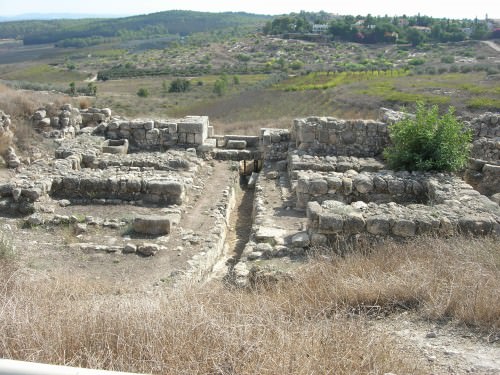
The remains of the six-chambered gate.
THE IRON AGE
During the Iron Age, Gezer was attacked many times. In addition, it was again conquered by Egypt, according to an inscription in Karnak dating to 918 BCE. Famed American archaeologist William F. Albright, longtime director of the American School for Oriental Research in Jerusalem in the 1920s CE and 1930s CE, stated that the pharaoh Shishak was responsible for the attack in the late 10 th century BCE. Albright went on to say that Gezer was then abandoned. However, pottery evidence suggests that the city continued to be inhabited by a substantial population in the 8 th and 7 th centuries BCE.
In the second half of the 8 th century BCE, the Assyrian king Tiglath-Pileser III (745–728 BCE) attacked and laid siege to Gezer. Then, after the Northern Kingdom of Israel was conquered by the Assyrians in the late 8 th century BCE, Gezer became part of the Kingdom of Judah. Finally, at the end of the 7 th and beginning of the 6 th century BCE, Gezer, like Jerusalem, was captured by the Neo-Babylonian king Nebuchadnezzar.
Many of the people of Judah were carried off to the lands to the east controlled by the Neo-Babylonians, and they remained there for several decades during the Babylonian Exile. However, beginning in 539 BCE, many of them returned to Judah after they were freed by an edict issued in that year by the Persian king, Cyrus the Great, who had conquered the Neo-Babylonians.
THE PERSIAN & HELLENISTIC /MACCABEAN PERIODS
After the Babylonian Exile, the former Kingdom of Judah, became the Persian province of "Yehud." Then, in the Hellenistic Period, the province became part of the Hellenistic Ptolemaic kingdom of Egypt. A seal found in Gezer shows that the city was part of the province of Yehud in the Persian and Ptolemaic periods.
In the Maccabean period, Gezer was captured by the Maccabees, and the Hasmonean kings Simon Maccabaeus and John Hyrcanus lived there, after which the city may have been temporarily deserted.

One of the boundary stones from the Roman period.
Herodian, Roman & Byzantine Periods
In the Herodian and Roman periods in the first century CE, Gezer seems to have been part of the estate of a Greek landowner named Alkios. It was apparently farmed by Jewish settlers who lived on the land. The inscribed boundary stones may belong to the Roman period. Tel Gezer may have been uninhabited after this, but in the Roman and Byzantine periods, it was apparently used as the location of tombs and structures other than dwellings.
The Murder of Julius Caesar › Antique Origins
Ancient Civilizations
Veni, vidi, vici! This was the simple message the Roman commander Julius Caesar sent to the Senate in Rome after a resounding victory in the east against King Pharnaces of Pontus - a message that demonstrated both arrogance as well as great military competence. “I came, I saw, I conquered!” also represented his future as leader of the Roman Republic.Although praised at first for both his military skills and ability to lead, he gradually began to bring fear into the minds of many of those inside as well as outside the Senate. Finally, a plot arose; friends soon became enemies and a brutal death came to a dictator.
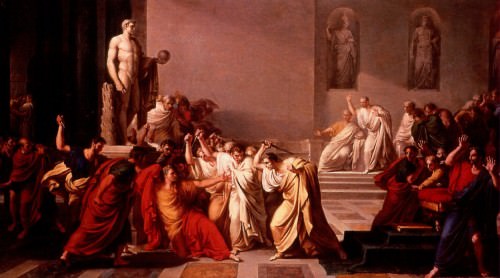
The Death of Julius Caesar
MILITARY SUCCESS & REFORMS
Gaius Julius Caesar had returned to Rome in triumph, hailed as a hero. During his time as a Roman general, he claimed to have killed almost two million people in fifty decisive battles. Although loved by the citizens of Rome, he caused, in many ways, worry among those in the Roman Senate - especially the old elite, the Optimates. The man who was soon to be hailed as dictator for life ( dictator perpetuo ) transferred his skill as a military commander into the ability to lead the Republic. Seeing the need and demonstrating that he truly loved the people of Rome, he decreed a number of significant and necessary reforms - reforms that further endeared him to the Roman citizenry. Always loyal to his army, one of his first endeavors was to offer land to seasoned veterans. Next, he gave grain to the urban poor and planned to move these same poor to the newly acquired colonies in Anatolia, Greece and North Africa. He limited the terms of the provincial governors while increasing the size of the Senate. He created a new calendar (still in use today), and provided both gladiatorial games and banquets as entertainment.The city of Rome had suffered violence and corruption, and was plagued by high unemployment. Caesar not only provided jobs through public work projects but also cleaned up the dangerous city streets. He even built a public library.
While these reforms made him popular among the commoners, they brought panic to many of his enemies and even some of his friends. To these men their beloved republic no longer existed, especially after Caesar was named dictator for life in February 44 BCE - a completely unconstitutional act. They believed they no longer had a voice as Rome was quickly coming under the control of a would-be tyrant. Caesar's extreme arrogance and vanity (he was very self-conscious about his balding head, for example) offended many in the Senate. This arrogance was most evident upon his victorious return to the city after the defeat of fellow Roman commander Pompey (also a member of the First Triumvirate ) in Spain. Adorned in triumphant garments and a laurel crown - something many people saw as unnecessary - Caesar rode into the city. Wars in the east had been against foreigners, but his victory in Spain saw the deaths of what many considered as their own sons and daughters.One tribune Pontus Aquila even refused to rise as Caesar passed - something that angered the conquering hero.
CAESAR'S HONOURS & PERCEIVED ARROGANCE
Despite the feelings of some, numerous honors were given him: he was awarded the titles of liberator and imperator; his birthday was made a public holiday; his birth month, Quinctilus, was renamed in his honor – Julius (July); and lastly, he was named both the father of his country as well as a consul for ten years. In all processions an ivory statue of Caesar was to be carried alongside the statues of the Roman gods - and all this was done without objection from Caesar. This arrogance became increasingly more evident as time passed: he sat attired in the purple regalia of the ancient Roman kings on a specially built golden chair while attending the Senate, often refusing to rise out of respect to any member who approached him. Further, he constructed a private palace on Quirinal Hill. Even those who knew him best came to believe he was losing his judgment - something his friends said was due to being overworked, tired, and troubled by his epilepsy.
CAESAR WAS BECOMING MORE OF A DIVINE FIGURE THAN A RULER WHICH WAS IN STARK CONTRAST TO MANY TRADITIONAL ROMAN BELIEFS.
Although those around him suffered through his arrogance, others believed the conquering hero was becoming more of a divine figure than a ruler which was in stark contrast to many traditional Roman beliefs. It is to be rembebred that the concept of an imperial cult was, as yet, several years in the future. Among friends, as well as enemies, there was a growing sense of animosity, questioning why the Senate allowed what appeared to them as blasphemy. Did Caesar actually believe he deserved this praise? To many he appeared to be more of a king than a ruler, someone no longer answerable to both the people of Rome and the Senate.
This heightened sense of self-worth was best seen during the annual February festival of Lupercalia. The Roman commander and always loyal Mark Antony attempted to place a diadem --- a wreathed laurel --- on Caesar's head while the “king,” adorned in the usual purple robe, was seated in the Forum on his gold throne, but Caesar pushed it away, refusing the gesture, stating that only Jupiter was the king of the Romans. Unfortunately, not everyone considered him to be sincere in his refusal. Many even believed he staged the entire event. Whether or not Caesar actually considered himself king, he always denied the title if called by it. The Roman orator and author Cicero --- an individual who had supported Pompey and known for his dislike for Caesar --- said that this was the beginning of the end for Rome.
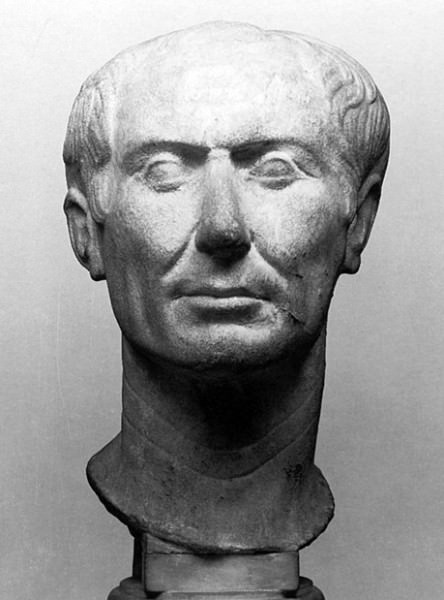
Bust of Julius Caesar
A CONSPIRACY RISES
The time had come to save the Republic from this would-be king, and thereby a conspiracy was borne. However, a plot not to just overthrow but to kill Caesar was a dangerous mission. Who would dare plan to kill the dictator for life of the Roman Republic, knowing if they failed, they would be branded as traitors? Of course, there were the usual, old enemies of Caesar - friends and supporters of Pompey who sought both high office and profit. Next, there were those who many believed were friends of Caesar, people who, while being rewarded for their loyalty, disliked many of his policies, especially his hesitance to overthrow the old, conservative Optimates. Further, they disapproved of his peace-making attempts with Pompey's supporters.And lastly, there were the idealists - those who respected the Republic and its ancient traditions. Individually, their reasons varied, but together, they believed the salvation of the Republic depended on the death of Caesar.
THE RINGLEADERS
The four leading men of the conspiracy were an unusual mix of both friends and enemies. The first two men believed they had not been rewarded substantially enough for their service to Caesar: Gaius Trebonius served as a praetor and consul and had fought with Caesar in Spain; Decimus Junius Brutus Albinus was governor of Gaul and had been victorious against the Gauls.The next two conspirators were obviously not friends of Caesar: Gaius Cassius Linginus who had served with both Crassusand Pompey as a naval commander and who some believe conceived the plot (Caesar certainly did not trust him), and lastly, the greedy and arrogant Marcus Junius Brutus who had also served under Pompey and who was the brother-in-law of Cassius.
Brutus was the son of Caesar's mistress Servilia (some mistakenly believed he was Caesar's son) and married to the Roman orator Cato's daughter Portia. Marcus Porcius Cato (or Cato the Younger), a strong supporter of Pompey and outspoken critic of Caesar, had committed suicide in 46 BCE while in North Africa. He had refused to surrender to Caesar after the commander's victory at Thapus. After Cato's death, both Cicero and Brutus wrote eulogies in praise of the fallen Roman. To Cicero Cato was the height of Roman virtue, a statement that angered Caesar. Despite all of this, Caesar believed in Brutus, forgave him, and supported him for a position as a praetor, which was a stepping stone to a consulship. There were other conspirators of course: Publius Servilius Casca, a tribune, who would strike the first blow against Caesar; Gaius Servilius Casca (his brother) who supposedly struck the final blow in the dictator's ribs; and lastly, Lucius Tillus Cimber, governor of Bithynia, who signaled the start of the attack. To these men power had to be, at any cost, wrested from Caesar and returned to the Roman Senate.
THE PLAN
Brutus believed there was considerable support for Caesar's assassination. These men met together secretly, in small groups to avoid detection. Luckily for the conspirators, Caesar had dismissed his Spanish bodyguard in October of 45 BCE, believing no one would dare attack him. The conspirators realized the attack had to be soon and swift as Caesar was making plans to lead his army on a three-year campaign against the Parthians, leaving on March 18. But where and when should they strike?Should they attack as Caesar rode on the highway the Appian Way or in a public place; could they attack while he was walking home on the Via Sacra (the Sacred Way); could they attack while he attended a gladiatorial games? After considerable debate, the final decision was to strike during a session of the Senate at the Theater of Pompey (the regular Roman Senate was being repaired) on March 15, 44 BCE, the Ides of March. The attackers had chosen their weapon of choice wisely - a double-edged dagger or pugio of about eight inches long instead of a sword. Daggers were better for close contact and could be hidden under their togas.
THE ATTACK
If one believes in omens, there were a number of reasons for Caesar not to attend the Senate meeting that day. First, Caesar's horses that were grazing on the banks of the Rubicon were seen to weep. Next, a bird flew into the Theater of Pompey with a sprig of laurel but was quickly devoured by a larger bird. Caesar's wife, Calpurnia had a dream of him bleeding to death in her arms. And lastly, a soothsayer named Spurinna warned him to beware of danger no later than the Ides of March.Unfortunately, Caesar put little faith in omens. The historian Suetonius wrote, “These warnings, and a touch of ill-health, made him hesitate for some time whether to go ahead with his plans or whether to postpone the meeting.” On the day of his death Caesar was truly sick and, as Suetonius said, hesitant about attending the meeting of the Senate, but the conspirator Decimus arrived at his home and urged him to not disappoint those waiting for him.
A large crowd accompanied Caesar on his way to the Senate. Just as he entered the theater a man named Artemidorus tried to warn him of eminent danger by thrusting a small scroll into his hand, but Caesar ignored it. The dictator entered and sat on his throne. Mark Antony, who had accompanied Caesar, was conveniently delayed outside by Trebonius, as planned. In the theater there were two hundred senators in attendance along with ten tribunes and a number of slaves and secretaries.Cimber approached the unsuspecting Caesar and handed him a petition on behalf of his exiled brother; Caesar, of course, did not rise to greet him. Cimber grabbed at Caesar's toga and pulled it back. Caesar reportedly said, “Why, this is violence?” Casca dealt the first blow with his knife; Caesar immediately tried to defend himself by raising his hands to cover his face. The remaining conspirators surrounded the shocked Caesar - Cassius struck him in the face, Decimus to the ribs. Caesar collapsed, dead, ironically at the foot of a statue of his old enemy Pompey. In all there were twenty-three blows. Suetonius described the attack, “… at that moment one of the Casca brothers slipped behind and with a sweep of his dagger stabbed him just below the throat. Caesar grasped Casca's arm and ran it through with a stylus; he was leaping away when another dagger caught him in the breast.” Despite the beautiful words of William Shakespeare Caesar did not say “E tu, Brute!” (You, too, Brutus!) as Brutus plunged his dagger into the dying dictator but “You, too, my child!” The remaining senators in attendance ran from the theater. Afterwards, Rome was in a state of confusion. Suetonius wrote that there were some, those who disliked Caesar, who wanted to seize the slain leader's corpse and throw it into the Tiber, confiscate his property, and revoke his laws; however, Mark Antony maintained a cool head and stopped any such plans.

Posthumous bust of Caesar
AFTERMATH
While the conspiracy had all the makings of a great plan, little attempt was made to prepare for afterwards. The conspirators made their way to Capitoline Hill and the Temple of Jupiter. Brutus spoke from a platform at the foot of the hill, trying in vain to calm the crowd. Meanwhile, slaves carried Caesar's body through the streets to his home; people wept as it passed. The funeral procession on March 20 was a spectacle unlike the one portrayed by Shakespeare, although Antony did give a short eulogy. A pyre had been built on the Field of Mars near the family tomb ; however, Caesar's body was quickly seized by locals and taken to the Forum where it was burned on a much simpler pyre. The ashes were returned to the Field of Mars and his family tomb; the city continued to mourn. In his The Twelve Caesars Suetonius wrote that Caesar may have been aware of the plot against him and because of ill-health knowingly exposed himself to the assault. “Almost all authorities, at any rate, believe that he welcomed the manner of his death…he loathed the prospect of a lingering end - he wanted a sudden one”
Brutus believed the death of Caesar would bring a return of the old Roman spirit; unfortunately, the city was in shock, and people became increasingly more hostile. On March 17 the Senate sought a compromise with the urging of Mark Antony: While the laws of Caesar would remain intact, there would be amnesty for the conspirators. Unfortunately, peace was impossible and the conspirators fled Rome and would all ultimately meet their end. Suetonius ended his chapter on the slain leader, “All were condemned to death … and all met it in different ways - some in shipwreck, some in battle, some using the very daggers with which they had treacherously murdered Caesar to take their own lives.” For Rome the young Octavian, the adopted son of Caesar, received not only his war chest but also the support of the army. A final conflict between Mark Antony (with the help of Cleopatra ) and Octavian would bring Octavian to power as Augustus, the first emperor of the Roman Empire.
LICENSE:
Article based on information obtained from these sources:with permission from the Website Ancient History Encyclopedia
Content is available under License Creative Commons: Attribution-NonCommercial-ShareAlike 3.0 Unported. CC-BY-NC-SA License